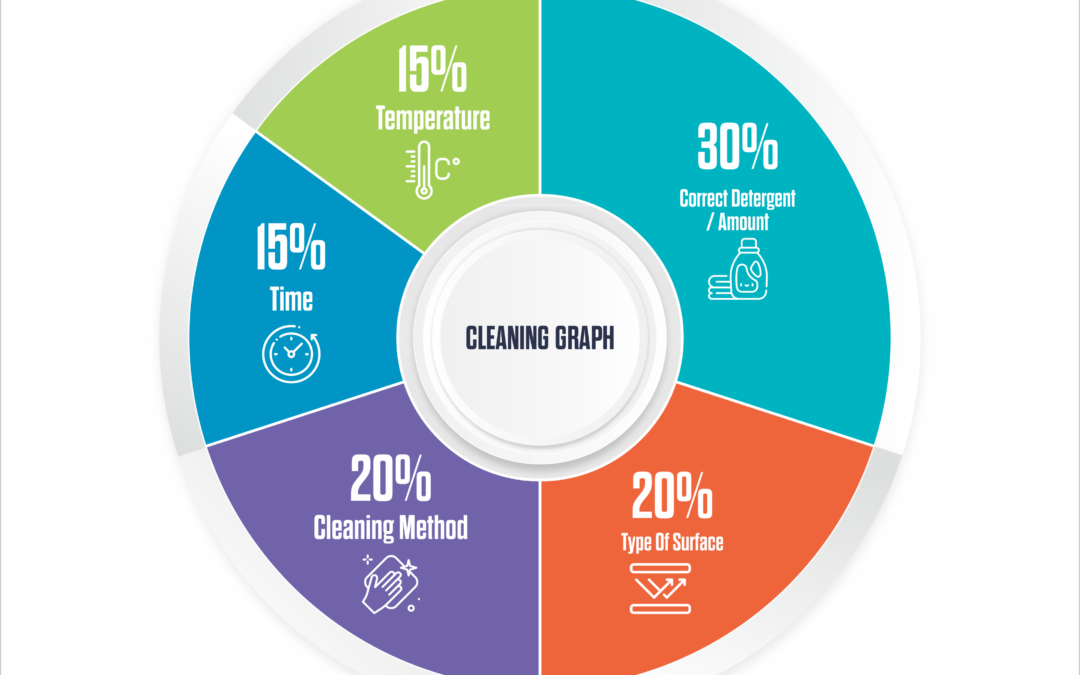Not all things are created equal when it comes to getting facilities clean. No two buildings are the same – no food and beverage production establishment, on-premise laundries, not even two schools are the same.
To clean and sanitize the area, you must first analyze the soils you are trying to remove and develop the best chemicals and procedures to get the job done.
The attached cleaning graph is how I analyze a problem and develop solutions.
Proper Detergent and Amount
In any cleaning job, from a laundry or retail store to a dairy or food production facility, you must use the correct chemical at the correct dilution to get optimal results. For food safety in particular, these guidelines need to be adhered to, especially regarding sanitizers. Usually, chemicals have technical instructions and will give you the ounces of chemical needed to use per gallon of water.
Sometimes this dilution is expressed as a percentage. So, for example, if a chlorinated foaming detergent was recommended at 2%, that equates to the number of ounces needed to be 2% of the total volume. If you were starting with 10 gallons of hot water, that is 1280 ounces, so 2% of that would be 25.6 ounces.
Often, cleaning successfully becomes challenging when an establishment decides to reduce those amounts to save money. Then, one of the other factors in my pie graph might increase. If you reduce chemical use, you might need to spend more money on time or temperature so that any cost savings may be negated.
Check out my post on how to pick the correct chemical.
Surface
You need to also match the chemical to the surface you are cleaning. For example, if it is a soft metal, you might need something with a more neutral pH. If you do not match these up correctly, acids and caustic agents can cause damage.
It is best to test before introducing a new product to a new situation. As in floor care, you should test the product first on a small area to make sure it works properly and does not cause any problems. My 40+ years of selling chemicals have shown me that experience does not overshadow chemical safety and respect, so I suggest testing every time you change chemicals or the surface it is being used on.
Cleaning Methods
Cleaning methods can change in a building as often as a shift changes. Just because the day crew does it one way does not mean the night crew does it the same way. That is why standard operating procedures (SOPs) must be in place. Sometimes small items are immersed in a solution, and while down the hallway, they use a clean-in-place (CIP) system. This is where a facility might ask for assistance from their chemical vendor because we see what other operations are doing and usually have advice. We can advise you on proper chemical selection after determining the proper method for specific areas.
Temperature
The proper way to clean things is to use the optimum temperature. The recommended temperature might be hard to attain in many cases, but this can be addressed. If you are using a chemical designed for hot water and cannot attain it, it may be best to replace that chemical versus extending the time, as I mentioned below.
Time
Time has many values. You must use the recommended time to finish the job the first time. Of course, if it goes over, it can cause problems in the chain of getting other things done. But time has value because it is usually equated with someone’s pay. Because some chemicals require a dwell time to work, you can minimize labor cost waste by training your employees to do other things while waiting.
Once I gave a floor care demo where I put hot water down with a stripper solution that needed to sit for 10 minutes before we could begin to use the black pad and floor care machine. As I waited, all the employees just stopped their work and watched as well, as if we were going to see something happening!
On the flip side, the key to dwelling time is not to let it get dry before the time is up, so please do not go the other route and cut the time short to free up your employees. Have other jobs assigned to your staff beforehand so that they are not just sitting around?
As a reminder, please use the proper personal protective equipment (PPE) when handling all chemicals.
In summary, look at the chart and understand that if you skimp in one area, it adjusts something in another area. You need to use proper procedures throughout the complete graph to get great results at a reasonable cost.
If you found this information helpful, please share it with others. If you need advice for your company, you can reach me via email at CONTACT.

